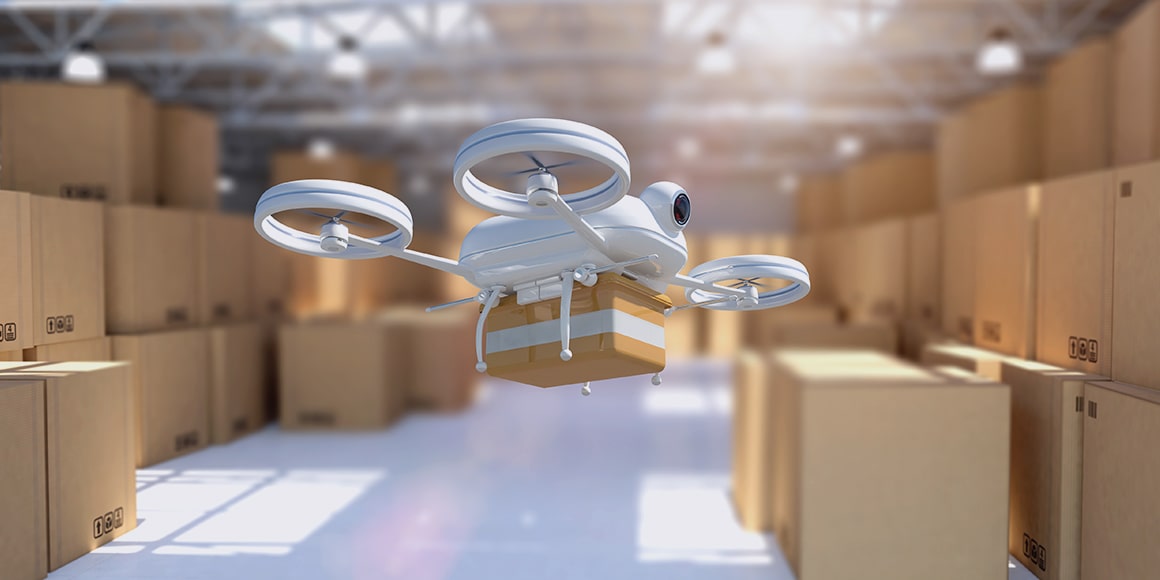
The push to modernize logistics processes has quickly accelerated during the pandemic. Retailers have seen drastic impacts on their supply chain operations as customers shift even more heavily toward e-commerce.
Many companies have been thrust into the future faster than expected and are ready to change their supply chain strategies. At the same time, they are struggling to identify the priorities that will most benefit their business.
One concept on the rise is decentralized fulfillment. This idea, made up of different shipping and logistics models, puts goods closer to the end buyer and allows for faster, more seamless order fulfillment.
To be competitive and agile in a quick-changing business environment, it is critical for businesses to understand and invest in decentralized technology and supply chain solutions.
The impact of decentralized shipping
Most logistics professionals have decentralized shipping models on their radar, according to a Forrester Consulting research study commissioned by USPS.[1]
The study focused on six decentralized logistics models: Buy Online Pick Up In Store (BOPIS), decentralized warehousing, endless aisle, Internet of Things, reverse logistics and Ship From Store.
Across the board, businesses indicate that these modern logistics programs drive efficiency and have a positive impact on their operations.
Efficiency drivers for modern logistics programs:
Companies also indicate that each of these programs is seen as effective when implemented.
Most effective logistics programs:
Find the right model
Decentralized shipping solutions provide a ton of value for companies building an agile future. Answer the two questions below to determine which models address your business’s priorities, or choose to explore all six shipping models at once.
Question 1 of 2
Select if your business is online only or has a brick-and-mortar location.
Your Results
Logistics leaders recommend six decentralized fulfillment models to help businesses stay competitive and flexible:
Here’s what logistics leaders recommend for online only stores:
Here’s what logistics leaders recommend to help onlinebrick-and-mortar and online businesses increase revenueimprove customer experiencecut inventory wastemaximize store valueadapt with agilitysee across the supply chainincrease efficiencyget higher-quality store trafficlearn customer preferencesmove older inventory:
Buy Online Pick Up in Store (BOPIS) Endless Aisle Internet of Things Ship From Store Decentralized Warehousing Reverse Logistics Change SelectionsSelect a model above to learn more or scroll to see all results
Buy Online Pick Up in Store (BOPIS)
Let customers buy online from store inventory, then pick up their orders in person. This model is dependent on having a brick-and-mortar location.
Logistics experts say BOPIS addresses these top priorities:
- Increase Efficiency
- Maximize Store Value
- Increase Efficiency
- Improve Customer Experience
- Adapt with Agility
“
No matter what they’re buying … the consumer is going to go where the convenience is.
Considerations:
35% of businesses without BOPIS noted that the program was not necessary for their customers.
Before implementing, consider these key points to help evaluate whether BOPIS is right for you:
- Is your customer base interested in this service?
- Do you have a physical store large enough to effectively pull and organize inventory for pickup?
- Are your customers close enough to conveniently come and pick up orders?
- Is the ROI for the tools and technology needed to run BOPIS enough to justify the investment?
- Do your teams have the bandwidth to effectively manage and run a successful BOPIS program?
- Do you have or can you achieve real-time visibility over your inventory?
Challenges:
40% of businesses using BOPIS said that they faced challenges with inventory availability.
Take these steps before introducing BOPIS devices for a smooth transition:
- Ensure you and your customers can clearly see which items are available from your inventory.
- Provide timely notifications to customers when orders are ready to pick up to prevent cart abandonment.
- Invest in scalable technology that is compatible with manufacturing and shipping partners.
- Properly train your teams and be realistic about what they can accomplish.
Endless Aisle
Enable customers in stores to virtually browse products that are not sold in stores or that are out of stock in a specific location, then ship the products to them. This model is dependent on having a brick-and-mortar location.
Logistics experts say endless aisle addresses these top priorities:
- Increase Revenue
- Move Older Inventory
- Cut Inventory Waste
- See Across the Supply Chain
- Learn Customer Preferences
“
It’s an interesting way to create sticky relationships with customers. If the customer needs 20 of those, then they don’t really care if two are coming from here and 18 are coming from there. At the end of the day, they want 20 by tomorrow at 9 p.m. That’s all they care about.
Considerations:
30% of businesses that don’t have endless aisle lack the real-time inventory visibility needed for it to work.
Before implementing, consider these key points to help evaluate whether endless aisle is right for you:
- Is your company set up to offer real-time inventory, or can you afford to upgrade and integrate your systems?
- Is the demand volume high enough to support the program financially?
- Can you effectively share data with internal and external partners?
- Will the investment in tools and technology pay off?
- Can you analyze data and forecast demand?
- Do you have a strong relationship with upstream partners?
Challenges:
31% of businesses that implemented endless aisle faced challenges with inventory availability.
Take these steps before implementing endless aisle for a smooth transition:
- Understand the limits of your endless aisle by working with manufacturers and logistics partners.
- Focus on enabling visibility from dock to stock with technology, tools or employee training.
- Evaluate communication channels and processes to eliminate miscommunication.
- Invest in technology that is scalable and compatible with manufacturing and shipping partners.
- Allocate time and resources to ensure essential employees are well trained.
Internet of Things
Implement interconnected devices, which all run over the internet, to communicate and optimize the supply chain.
Logistics experts say Internet of Things addresses these top priorities:
- Increase Revenue
- Learn Customer Preferences
- Increase Efficiency
- Improve Customer Experience
- Adapt with Agility
“
It’s easier to have a system in place to let me see where things are at any given time. Right now, I don’t have the visibility. I have to call people and they have to track and check on items, and it’s a pain.
Considerations:
36% of businesses not using Internet of Things devices cited a lack of inventory visibility.
Before implementing, consider these key points to help evaluate whether this model is right for you:
- Do you have the right systems in place to monitor real-time inventory?
- Can you justify large upfront costs for long-term benefits?
- Can you allocate time and resources for stakeholder training?
- Are your different stores and warehouses communicating effectively?
- Do you have logistics partners who can execute this model, or can you easily establish new partnerships?
Challenges:
40% of businesses who use the Internet of Things in their logistics process said they lacked the technology and tools needed to manage the program.
Take these steps before introducing Internet of Things devices for a smooth transition:
- Evaluate technology and tools that work for you and your partners.
- Weigh the ROI from implementing these devices against the cost of managing the program to ensure your margins will justify the use.
- Allocate time and resources for training your employees.
- Create systems and programs that are compatible across internal and external locations.
- Get stakeholder buy-in.
- Educate and train your team on an ongoing basis.
Ship From Store
Use in-store inventory to more quickly and efficiently fulfill orders. This model is dependent on having one or more brick-and-mortar locations.
Logistics experts say Ship From Store addresses these top priorities:
- Increase Revenue
- Get Higher-Quality Store Traffic
- Increase Efficiency
- Improve Customer Experience
- Move Older Inventory
“
We always try and consolidate our shipments between retail, our distribution centers and our customers. It really depends on the volume of the store. It’s important to keep this in balance because our stores have limited space.
Considerations:
42% of businesses not using Ship From Store either did not have a storefront or have a store with limited space.
Before implementing, consider these key points to help evaluate whether Ship From Store is right for you:
- Is your store large enough to support the Ship From Store model?
- Is the long-term ROI enough to justify the initial investment?
- Do you have real-time visibility into your inventory?
- Are all of your inventory systems communicating effectively?
- Do your teams have the bandwidth to train on, manage and run shipping from a storefront?
Challenges:
37% of businesses using Ship From Store said they faced challenges with inventory availability.
Take these steps before implementing Ship From Store for a smooth transition:
- Understand consumer demand at the SKU level and share that data with internal and external partners.
- Ensure inventory is always in the right place to avoid lost sales, misused space and customer dissatisfaction.
- Weigh the short-term investment against the long-term payoff of Ship From Store.
- Invest in scalable technology that is compatible with manufacturing and shipping partners.
- Launch a pilot in select regions to gauge feasibility and monitor its cost, roadblocks and successes.
Decentralized Warehousing
Maintain a connected network of smaller warehouses across different areas to better serve specific markets.
Logistics experts say decentralized warehousing addresses these top priorities:
- Increase Efficiency
- Cut Inventory Waste
- See Across the Supply Chain
- Improve Customer Experience
- Adapt with Agility
“
There’s a certain level of fixed cost and one-time setup cost, be it to lease your own warehouses or to start working with a third-party partner that offers multi-warehouse options. And until you get to a certain scale, the profit you’re generating doesn’t offset the fixed costs for the upfront investment.”
Considerations:
31% of businesses that don’t use decentralized warehouses couldn’t coordinate effectively enough with stores to use this model.
Before implementing, consider these key points to help evaluate whether decentralized warehousing is right for you:
- Can you effectively transfer information and goods between locations to fill orders?
- Does the ROI offset the expenses, including upfront costs, maintenance and repairs?
- Do you have visibility across your stores, departments and external partners?
- Does each location understand the importance and benefit of having multiple distribution centers?
- Can you justify large upfront costs for long-term benefits?
Challenges:
28% of businesses that have decentralized warehouses said they had trouble linking warehouse inventory levels with stores.
Take these steps before implementing decentralized warehousing for a smooth transition:
- Find technology that works for internal and external data sharing.
- Develop processes to ensure that data collection is timely and accurate.
- Train employees and stakeholders to identify risks and remedy issues effectively.
- Be selective with technology and tools to make sure they work with your partners and achieve your goals.
- Allocate time and resources to hiring, onboarding and educating employees.
Reverse Logistics
Create an automated process for moving returns from consumer back to the point of origin, then from the warehouse back out to the market (when possible) for resale.
Logistics experts say reverse logistics addresses these top priorities
- Learn Customer Preferences
- Maximize Store Value
- Increase Efficiency
- Improve Customer Experience
- Adapt with Agility
“
[Returns are] partially a technology play, but also partially a process play. … How do we make sure that the [initial] delivery is accurate? How do we make sure that we can change invoices on the fly and make sure they are accurate? And then, what is our process to reduce any non-technology related inaccuracies? And then, finally, can we change?”
Considerations:
35% of businesses that don’t have a reverse logistics program said it was because of cost concerns.
Before implementing, consider these key points to help evaluate whether reverse logistics are right for you:
- Does the upfront cost of onboarding the program offset the potential revenue loss of not implementing it?
- What are the hidden costs of returns, and how are they offset by the benefits?
- Can you develop and implement training and protocols to ensure staff is properly trained to handle incoming products?
- Do you have the right logistics partners to execute returns, or can you establish new partnerships easily?
- Does your technology communicate easily both internally and externally?
Challenges:
34% of businesses that implemented a reverse logistics process said they lacked the logistics ability to make returns cost effective.
Take these steps before implementing a reverse logistics process for a smooth transition:
- Evaluate your network and define the parameters of your returns policy to ensure it is cost efficient.
- Monitor and adjust your processes so that expensive mistakes are found and fixed quickly.
- Plan to invest money and time for training.
- Compare price and person-to-person interactions with multiple potential partners to find the right fit.
Tips for effective implementation
(from executives who’ve done it)
- Invest in demand planning. Connect the dots between technology, data, people and process to gain efficiencies and mitigate risks across the supply chain.
- Be agile. Adapt quickly to deal with disruptions from consumer behaviors to overall market supply. Build flexibility into the business to meet the next change with confidence.
- Build valuable partnerships. Find partners who are experts in their areas and leverage those relationships to build a successful business ecosystem.
- Automate. Increase efficiency across multiple locations, departments and channels by putting in place and using the right tools.
- Monitor and track. Follow the performance of new models as they are implemented. It may not be seamless at first, but visibility and awareness can help with the adjustment.
Key Takeaway
The time to modernize shipping and logistics processes is now. Leverage the knowledge and of industry leaders to learn how to operate smarter, faster.
Though the retail environment is changing rapidly, stay focused on your business priorities. Find ways to introduce agility that make sense for your business so that you can better respond to real-time changes. Understand the benefits and requirements of these different decentralized e-commerce models to ensure that any investments in technology, training and programs will pay off.
Know that these integral updates will make a lasting impact on the efficiency and long-term success of your business.
Footnotes
keyboard_arrow_down- [1]USPS commissioned Forrester Consulting to conduct a research study with 317 U.S. decision-makers in e-commerce, marketing and supply chain with authority around logistics, fulfillment and marketing in April 2020. arrow_right_alt
- [2]Ibid. arrow_right_alt
- [3]Ibid. arrow_right_alt
- [4]Ibid. arrow_right_alt
- [5]Ibid. arrow_right_alt
- [6]Ibid. arrow_right_alt
- [7]Ibid. arrow_right_alt
 search
close
menu
search
close
menu



